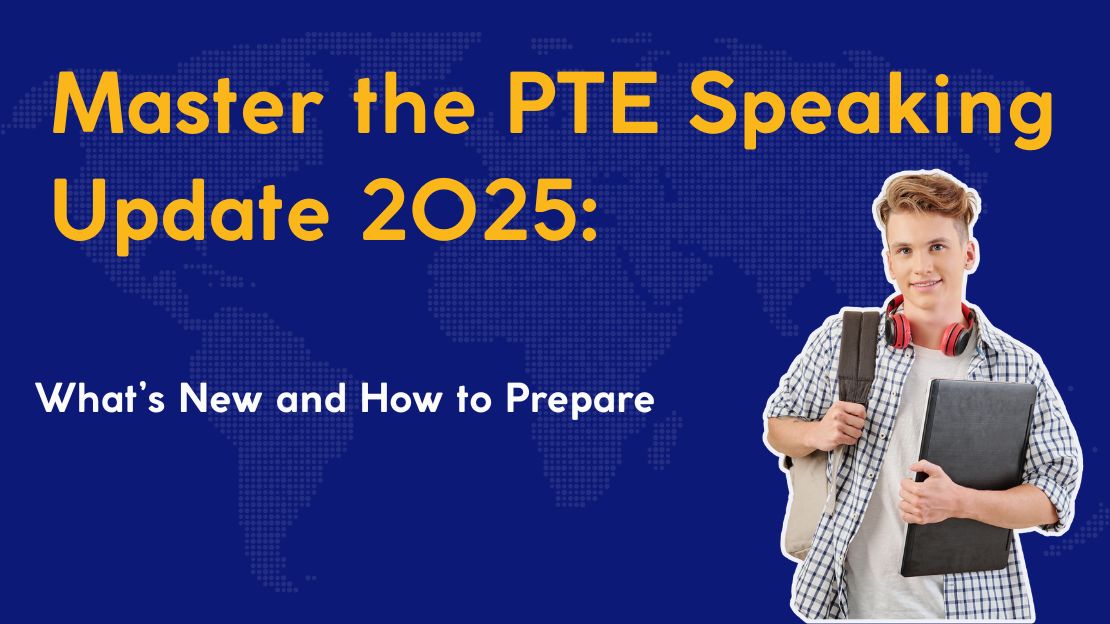Master the PTE Speaking Update 2025: What’s New and How to Prepare

From 7th August 2025, the PTE Speaking section is getting a much-needed upgrade—and if you're planning to take the test after that date, it’s important to know what’s changing. Pearson is introducing two PTE Academic New Questions Format that aim to test how well you use English in everyday situations, not just how well you remember grammar rules. These updates are practical, relevant, and even consider real-life communication challenges like ""—making the exam feel more real than ever.
Let’s break down what these new tasks are all about and how you can start preparing today.
🔄 Why Did Pearson Update the Format?
The world has changed—and so has the way we use English. It’s no longer just about academic essays or formal writing. Whether you’re in a classroom, a Zoom meeting, or talking with a customer, clear and confident speaking matters.
That’s why Pearson updated the test to focus on real-world communication. These changes are designed to measure your ability to:
Understand different points of view
Respond naturally and appropriately
Speak clearly, under pressure, and in context
The goal? To better reflect how English works in real life—not just in textbooks.
🆕 What Are the New Speaking Tasks?
You’ll now face two new speaking tasks:
✅ 1. Summarize Group Discussion
✅ 2. Respond to a Situation
Both tasks are short, practical, and require active listening, quick thinking, and clear speaking.
📘 Task 1: Summarize Group Discussion
What You’ll Hear:
A 2–3 minute recording of a group discussion on a topic
You get 10 seconds to prepare
You speak for 2 minutes, summarizing what was said
How to Do It Well:
Focus on identifying the main ideas from at least two speakers. Don’t worry about remembering every word—just capture the key points.
Structure your answer like this:
“The group discussed the topic of…”
“Speaker A believed…, while Speaker B pointed out…”
“In summary, several viewpoints were shared.”
Quick Tips:
Use formal and objective language
Don’t include your personal opinion
Practice with group podcasts or debates to get used to following multiple speakers
🎤 Task 2: Respond to a Situation
What You’ll Hear:
A 20–30 second audio describing a realistic scenario (e.g., a workplace or social issue)
You’ll get 10 seconds to prepare
You speak for 40 seconds, offering a helpful, appropriate response
How to Do It Well:
Pretend you’re in that situation. Think about what you’d actually say in real life, but keep it polite and professional.
Try this format:
“Thanks for letting me know…”
“I understand the issue and I’ll do my best to help.”
“I’ll get back to you as soon as I can.”
Quick Tips:
Keep your response simple and clear
Avoid overthinking—be natural
Use polite expressions and a steady tone
📌 Quick Format Recap
Summarize Group Discussion
Audio: 2–3 minutes
Prep: 10 seconds
Speak: 2 minutes
Goal: Summarize different opinions using formal language
Respond to a Situation
Audio: 20–30 seconds
Prep: 10 seconds
Speak: 40 seconds
Goal: Provide a helpful response in a real-world context
📚 How to Prepare for These New Tasks
1. Practice Active Listening
Watch videos with group discussions or team meetings
Pause and jot down who said what
Practice summarizing the conversation in 1–2 minutes
2. Simulate Real Situations
Use everyday prompts like:
“Your friend forgot their appointment.”
“A customer received the wrong product.”
“Your teammate didn’t show up for a meeting.”
Record yourself answering within the time limit.
3. Use a Clear Structure
Whether summarizing or responding, stick to:
Intro → Details → Wrap-up
Linking phrases help too:
“Firstly…”
“However…”
“To conclude…”
4. Build Fluency and Pronunciation
Read out loud daily from news articles or blogs
Shadow native speakers from YouTube or podcasts
Use apps for pronunciation and pace feedback
💬 Helpful Vocabulary and Expressions
For Group Summaries:
“The discussion revolved around…”
“There were opposing viewpoints regarding…”
“Speaker A argued…, while Speaker B had a different perspective…”
For Responding to Situations:
“I understand your concern.”
“Let me check and get back to you.”
“I’ll make sure this is sorted out quickly.”
✅ Do’s and Don’ts
✅ Do:
Stay calm and speak clearly
Use professional and polite language
Stick to the question
Practice under timed conditions
❌ Don’t:
Share personal opinions in Task 1
Use slang or overly casual words
Rush through your response
Repeat the audio prompt
🎯 Final Thoughts
The PTE Academic New Questions Format isn’t about memorizing perfect answers—it’s about using English the way people actually use it. These two new tasks—Summarize Group Discussion and Respond to a Situation—are your chance to show that you’re not only fluent, but also effective in real conversations.
With regular practice and smart strategies, you can master these tasks and walk into test day with confidence.
Source: Angel EduNext
